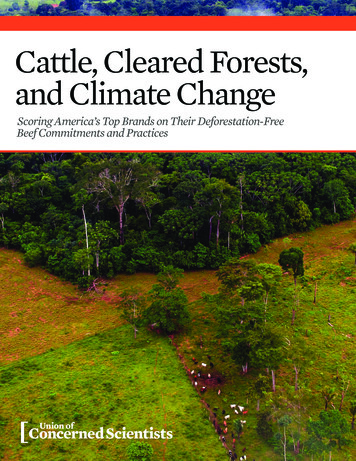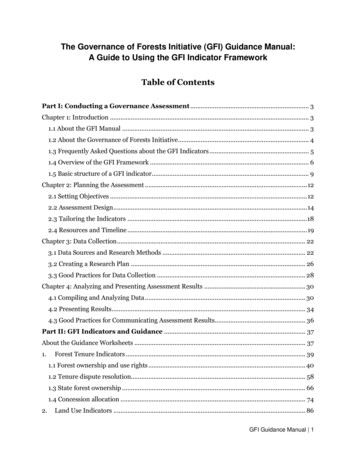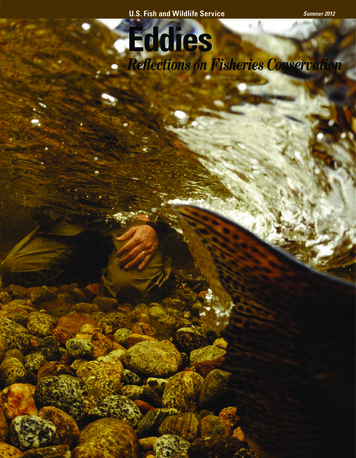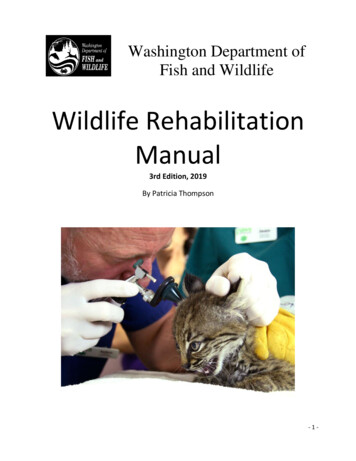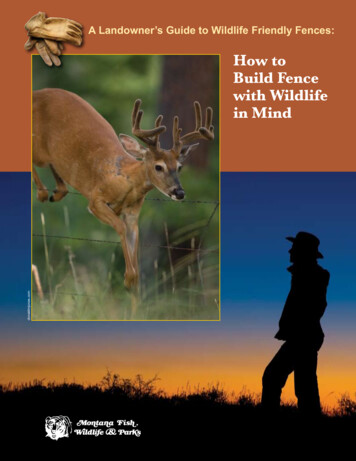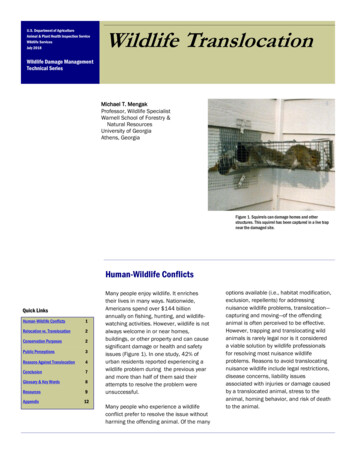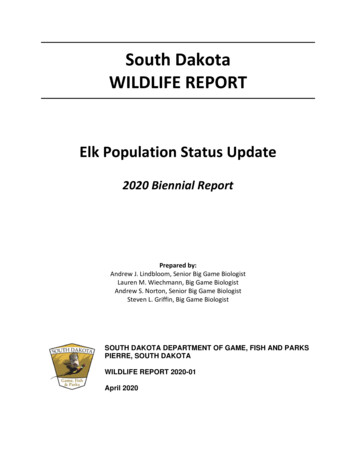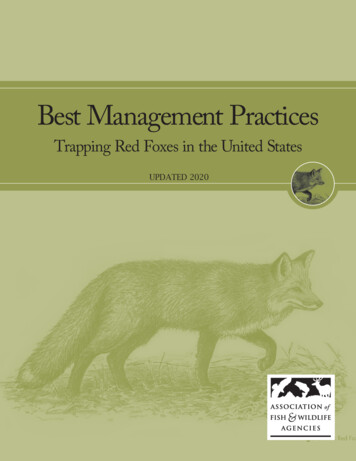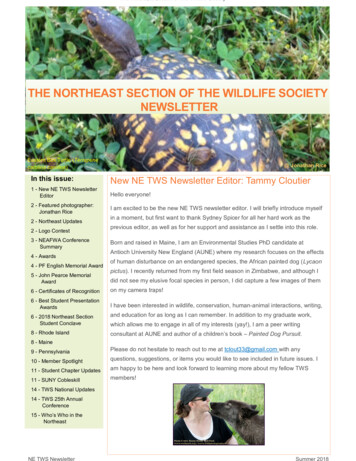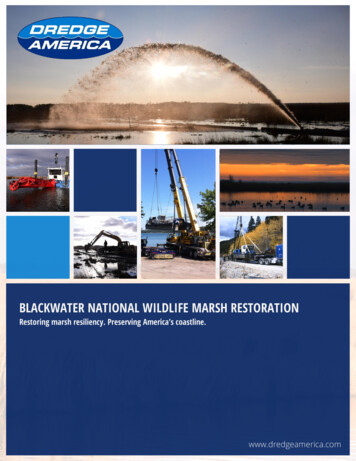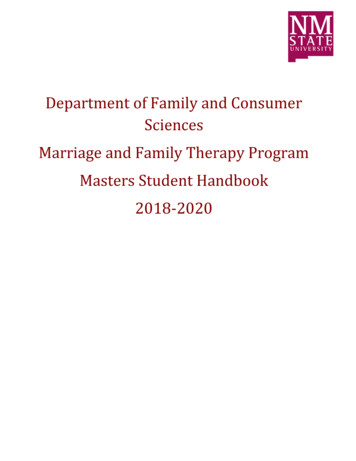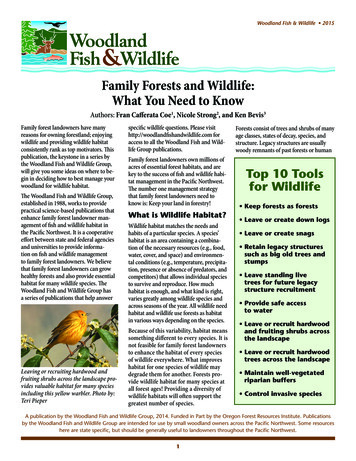
Transcription
Woodland Fish & Wildlife 2015Family Forests and Wildlife:What You Need to KnowAuthors: Fran Cafferata Coe1, Nicole Strong2, and Ken Bevis3Family forest landowners have manyreasons for owning forestland; enjoyingwildlife and providing wildlife habitatconsistently rank as top motivators. Thispublication, the keystone in a series bythe Woodland Fish and Wildlife Group,will give you some ideas on where to begin in deciding how to best manage yourwoodland for wildlife habitat.The Woodland Fish and Wildlife Group,established in 1988, works to providepractical science-based publications thatenhance family forest landowner management of fish and wildlife habitat inthe Pacific Northwest. It is a cooperativeeffort between state and federal agenciesand universities to provide information on fish and wildlife managementto family forest landowners. We believethat family forest landowners can growhealthy forests and also provide essentialhabitat for many wildlife species. TheWoodland Fish and Wildlife Group hasa series of publications that help answerLeaving or recruiting hardwood andfruiting shrubs across the landscape provides valuable habitat for many speciesincluding this yellow warbler. Photo by:Teri Pieperspecific wildlife questions. Please visithttp://woodlandfishandwildlife.com foraccess to all the Woodland Fish and Wildlife Group publications.Forests consist of trees and shrubs of manyage classes, states of decay, species, andstructure. Legacy structures are usuallywoody remnants of past forests or humanFamily forest landowners own millions ofacres of essential forest habitats, and arekey to the success of fish and wildlife habitat management in the Pacific Northwest.The number one management strategythat family forest landowners need toknow is: Keep your land in forestry!Top 10 Toolsfor WildlifeWhat is Wildlife Habitat?Wildlife habitat matches the needs andhabits of a particular species. A species’habitat is an area containing a combination of the necessary resources (e.g., food,water, cover, and space) and environmental conditions (e.g., temperature, precipitation, presence or absence of predators, andcompetitors) that allows individual speciesto survive and reproduce. How muchhabitat is enough, and what kind is right,varies greatly among wildlife species andacross seasons of the year. All wildlife needhabitat and wildlife use forests as habitatin various ways depending on the species.Because of this variability, habitat meanssomething different to every species. It isnot feasible for family forest landownersto enhance the habitat of every speciesof wildlife everywhere. What improveshabitat for one species of wildlife maydegrade them for another. Forests provide wildlife habitat for many species atall forest ages! Providing a diversity ofwildlife habitats will often support thegreatest number of species. Keep forests as forests Leave or create down logs Leave or create snags Retain legacy structuressuch as big old trees andstumps Leave standing livetrees for future legacystructure recruitment Provide safe accessto water Leave or recruit hardwoodand fruiting shrubs acrossthe landscape Leave or recruit hardwoodtrees across the landscape Maintain well-vegetatedriparian buffers Control invasive speciesRoosevelt ElkA publication by the Woodland Fish and Wildlife Group, 2014. Funded in Part by the Oregon Forest Resources Institute. Publicationsby the Woodland Fish and Wildlife Group are intended for use by small woodland owners across the Pacific Northwest. Some resourceshere are state specific, but should be generally useful to landowners throughout the Pacific Northwest.1
Woodland Fish & Wildlife 2015activities and have great value as habitatfeatures. These can include old stumps,logs, snags, or even wood piles, providing habitat for many different types ofanimals.The following sections will provideguidance on providing key componentsof wildlife habitat at all forest agesand types.FoodWildlife look for food (forage) in manydifferent ways. Family forest landowners have many tools to enhance foragingopportunities for wildlife: If you harvest, leave some standinglive conifers in your harvest units. Leave deciduous (hardwood)trees and shrubs (where practicable),particularly fruit bearing species,across all forest ages and types. Leave or create snags and down logsacross all forest ages and types. Maintain riparian buffers on all waterways with a diversity of tree and shrubspecies. Consider wildlife-friendly seed mixeson your dirt roads, skid trails, andother disturbed areas. This will helpwildlife and hopefully prevent thosedisturbed areas from becoming full ofinvasive species.Safe Access to WaterWater is essential for wildlife species.There are many ways that familyforest landowners can provide waterfor wildlife:Providing access to water sources isessential for local wildlife. Photo by:Michael AhrWildlife need cover to hide from predators. Photo by: Ken Bevis Maintain riparian buffers on allwaterways; this includes conifer andhardwood trees, shrubs, and plants. Enhance existing ponds so they arewildlife friendly; this includes keepingponds well-aerated, vegetated, and freeof invasive species. Protect known water sources suchas creeks and springs with buffers.This might include actions such aspreventing livestock from entering thearea or maybe just keeping an eye onwater sources to make sure they arewell vegetated. Consider creating artificial wateropportunities (such as putting inwater fountains, or installing watertroughs, etc.) if no natural watersources are available.CoverWildlife need cover to hide from predators, raise their young, to rest, and toprotect themselves from harsh weatherconditions. Wildlife look for cover inmany different ways. Family forestlandowners have many tools to providecover for wildlife: Retain existing legacy structures, suchas old “wolf ” trees (wolf trees are largetrees with multiple branches along theentire trunk), snags, and down logs.2 Leave or create brush piles by placinglarge woody material (6” or greaterin diameter) in at least 4 layers on thebottom and then cover these layerswith fine branches on top. Leave or create snags and down logsgreater than 12 inches in diameteracross all forest ages and types. Leave patches of dense shrubs inthinned forests (shrub patches 30 feetin diameter work well). Leave patches or grassy areas unmowed (or wait until late summer orearly fall to mow). Leave clumps of leave trees in harvestunits.SpaceWildlife require space to find food andwater and to raise their young. Oftenwildlife need to move between habitatWildlife, such as this northern pygmyowl, need space to find food and raisetheir young. Photo by: Roy Siegel
Woodland Fish & Wildlife 2015Observations of wildlife species andhabitat conditions can provide indicators of habitat change over time. Thereare many tools and techniques availableto private landowners that will help tomake informed and practical monitoring decisions. This can range from yourcasual observations to standardized birdscounts. Our publication Techniques andTools for Monitoring Wildlife on SmallWoodlands will help you dig deeper.What about wildlife damage onmy forest?Techniques for enhancing wildlife habitatinclude vegetation manipulation andsometimes making habitat structuressuch as the snags pictured here. Photoby: Ken Bevistypes at various stages of their life. Familyforest landowners often provide the linkbetween habitat types that allows ease ofmovement for wildlife. The following aretools to enhance wildlife movement: Minimize fencing or utilize seasonalfencing that you can lay down duringknown periods of time wildlife travelacross your property. Connect your forest to adjacent habitattypes by planting or retaining a swathof trees and shrubs. This will create amovement corridor that is essential formany wildlife species. Maintain riparian buffers.It’s true that some wildlife species canbe detrimental for landowners tryingto grow forests. For example, mountainbeavers can be devastating in youngplantations and deer often browse youngsaplings. There are many resources available to landowners looking for solutionsto wildlife damage. We recommend thefollowing sites to learn tp://www.dfw.state.or.us/wildlife/living ic/gardening/wildlife.Can I create or enhance wildlifehabitat?Techniques for enhancing wildlife habitatinclude vegetation manipulation and sometimes making habitat structures. Createdsnags, habitat piles, and nest boxes aremanagement tools that landowners use toenhance wildlife habitat on their properties. These are great tools especially whennatural features are lacking. It is importantto note that some created structures requireannual maintenance (e.g., nest boxes). Artificial structures should be used to augment,not replace natural habitat features. Tolearn more about creating artificial wildlifehabitat such as nest boxes please see ourpublication on Cavity Nesting Birds.Where else can I go for moreinformation?There are numerous resources availableto help landowners manage for wildlifeon working forests. Here are some werecommend: N atural Resources Conservation Service O regon Department of Fish and Wildlife W ashington Department of Fish andWildlife L ocal Watershed Councils U .S. Forest ServiceHow do I know if I’m makinga difference for wildlife on myproperty?Systematic observations and monitoringof wildlife can be a lot of fun, can helpyou understand your property, and helpyou reach your management objectives.Monitoring is simply identifying species,ecologically important areas, habitatfeatures, and collecting baseline data tocompare against future assessments. Itmight also include identifying potentialproblems (e.g., wildlife damage or invasive species).Habitat piles are an example of management tools that landowners use to enhancewildlife habitat on their properties. Photo by: Michael Ahr3
Woodland Fish & Wildlife 2015 A PHIS O regon Department of Forestry W ashington Department of NaturalResources E xtension offices O regon Forest Resources Institute Local Soil and Water ConservationDistrictshensive information on fish and wildlifehabitat resources in Washington. Landowners in Washington can access the PHSprogram to determine what habitats maybe present on their property, what wildlife depend on those habitats, and specifictools to manage for those species.For example: The pileated woodpeckeris found in mature forest habitats, andacts as a keystone species there. Generalrecommendations for this species includeretaining large snags and managing formature forests where large snags willexist.How do I know which species Iam likely to help on my property?Implementing the actions outlined abovewill benefit wildlife species across all forest ages and types. There are several waysto find out more about which species anindividual landowner may be benefiting.The Oregon Conservation Strategy is atool in Oregon that provides informationon at-risk species and habitat, identifieskey issues affecting them, and recommends actions. The online tools for theOregon Conservation Strategy will helpyou understand which Ecoregion yourforest is located in, what habitats may bepresent, what wildlife depend on thosehabitats, and finally specific tools to manage for those species.For example: the acorn woodpecker livesin oak woodlands in the Willamette Valley Ecoregion. The Oregon ConservationStrategy (OCS) suggests working withUsing the Oregon Conservation Strategycan help identify tools for helping at riskspecies such as this acorn woodpecker.Photo by: USFWSfamily forest landowners to maintainand restore oak woodlands with openunderstories, especially large patches andmaintain snags and older trees with deadlimbs.Information on the OCS may be foundhere: n Washington, the Priority Habitats andSpecies (PHS) program provides compre-Information on the PHS may be foundhere: http://wdfw.wa.gov/conservation/phs/mgmt recommendations/.How do I get started?Family forest landowners regularlyobserve wildlife on their property.Improved land management for wildlifecan benefit from systematic recordingof these wildlife observations, and usingthis information to hone specific wildlifehabitat management actions will help tomeet your objectives.The worksheet on the next two pages isdesigned to help you determine whatwildlife occur on your land, those wildlifespecies you may be able to support, helpyou establish wildlife habitat management goals, and identify next steps forhabitat management on your property.Providing a variety of habitats across thelandscape will benefit many species. Thecedar waxwing pictured here will benefitfrom fruit-bearing trees and shrubs.Photo by: Mark Penninger4
Woodland Fish & Wildlife 2015Wildlife Evaluation Worksheet1. Sketch a map of your property and include the different habitat (or stand) types (for example, wetlands orpond, forested areas, houses, fences, grasslands)2. Are there any habitat types on your property that are priority habitats in Oregon or Washington?(See Keystone publication for information on priority habitat types through the Oregon ConservationStrategy and Washington Priority Habitats and Species program referenced above).5
Woodland Fish & Wildlife 20153. For each habitat type identified above, list the features of that habitat type that are important for wildlifethat are present (down logs, snags, shrubs, hardwood trees, legacy structures, water sources, etc.).4. List any wildlife species that have been observed on your land. If you don’t know the species, just describethem. Where were they? How many? What were they doing? What time of day/year did you see them?5. List any wildlife goals (enhancement and/or creation) you have for your property and actions you mighttake to accomplish these goals in the next 5 years.GoalActionExample: increase songbird nesting and feeding habitatExample: increase hardwood shrubs (increase space andplant desired shrub)6. List any wildlife that are causing damage to your property or interfering with other goals and objectives forthe property. What actions can you take to address this conflict?7. List any tools and techniques you plan to use to monitor success of your wildlife habitat goals.8. List any sources you are considering contacting for further technical or financial assistance.6
Woodland Fish & Wildlife 2015Additional Information Sources:Oregon Department of Fish and Wildlife Living with Wildlife: http://www.dfw.state.or.us/wildlife/living with/Bevis, Ken. Fall 2013. Deer Winter Range. Washington State University Forestry Extension Newsletter: Fall 014/02/17/deer-in-winter/.Know Your Forest Website. gon Forest Resources Institute. 2013. Wildlife in Managed Forests: Deer and eer for web.pdfRocky Mountain Elk Foundation. 2013. Elk Facts. www.rmef.org/ElkFacts.aspx.Washington Department of Fish and Wildlife: Living with Wildlife http://wdfw.wa.gov/living/deer.html.Washington Department of Fish and Wildlife: Living with Wildlife: http://wdfw.wa.gov/living/elk.html.Washington State Department of Natural Resources. 2009. Wildlife Fact 2014/02/Forage Mixes.pdfWisdom, Michael J., and John G. Cook. 2000. North American Elk. Chapter 32 in Denarais, Stephen, and Paul R. Krausman,Ecology and Management of Large Mammals in North America. Prentice Hall, Upper Saddle River, NJ.Cook 2005About The Woodland Fishand Wildlife GroupThe Woodland Fish and Wildlife Group is aconsortium of public agencies, universities,and private organizations which collaborates to produce educational publicationsabout fish and wildlife species and habitatmanagement for use by small woodlandowners in the Pacific Northwest.Publications are available and can beviewed and downloaded, free of charge,at the organization’s website:www.woodlandfishandwildlife.comWoodland Fish and Wildlife publications are not copyrighted and may bereproduced with appropriate credit to theorganization and the author(s).Comments or othercommunications may bedirected to:Woodland Fish and Wildlife Groupc/o Executive DirectorWestern Forestry and ConservationAssociation4033 SW Canyon RoadPortland, OR 97221(503) 226- 4562richard@westernforestry.orgThe Woodland Fish and Wildlife Groupgratefully acknowledge funding supportprovided by USDA Forest Service, PacificNorthwest Region, State and PrivateForestry.Spike Elk. Photo by: Ken BevisAuthors:Fran Cafferata Coe, Cafferata Consulting, Hillsboro, OR1Nicole Strong, Oregon State University Extension, Redmond, OR2Ken Bevis, Washington State Department of Natural Resources, Olympia, WA37
a difference for wildlife on my . property? Systematic observations and monitoring . of wildlife can be a lot of fun, can help you understand your property, and help . .S. Forest ServiceU. Habitat piles are an example of management tools that landowners use to enhance wildl
